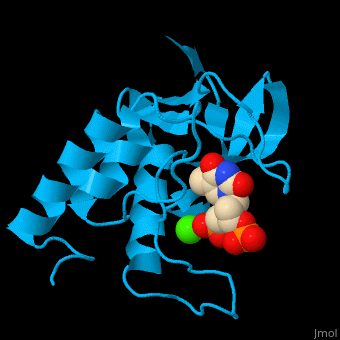Micrococcal nuclease, or Staphylococcal nuclease or Nuclease A or thermonuclease, is a monomeric Ca++ dependent enzyme of 149 amino acids that cleaves either DNA or RNA substrates. It is used for relatively non-specific cleavage of nucleic acids in molecular biology, and has been an important model system for the study of protein folding.
Structure
The first structure was solved in 1969 in the Cotton lab at MIT, published in 1971[1], and deposited in the PDB as now-obsoleted 1sns in April 1974. The highest resolution wildtype structure in the PDB with deposited data is 2snc at 1.65A[1]. As seen in the ribbon diagram above, the nuclease molecule has 3 long alpha helices and a 5-stranded, barrel-shaped beta sheet, in an arrangement known as the OB-fold (for oligonucleotide-binding fold) as classified in the SCOP database. There are about 300 PDB entries for Staph. nuclease, including extremely extensive mutational studies from many labs focused on understanding aspects of protein folding[2][3][4].
- . Water molecules are shown as red spheres.
- .
3D structures of Staphylococcal nuclease
Staphylococcal nuclease 3D structures

